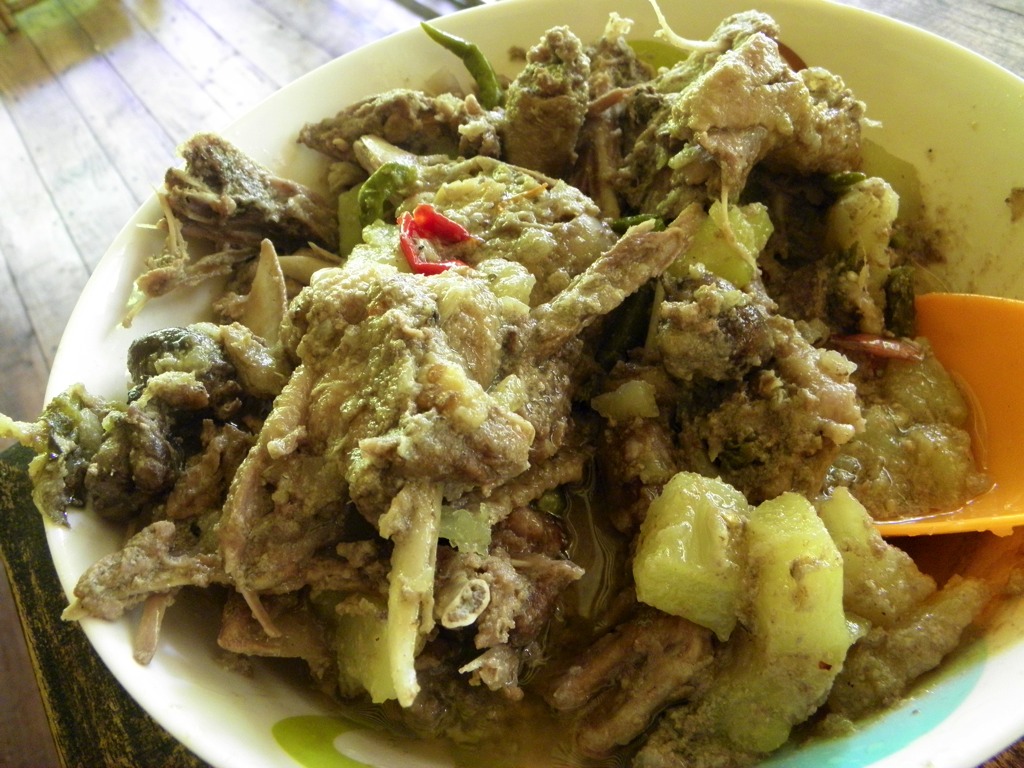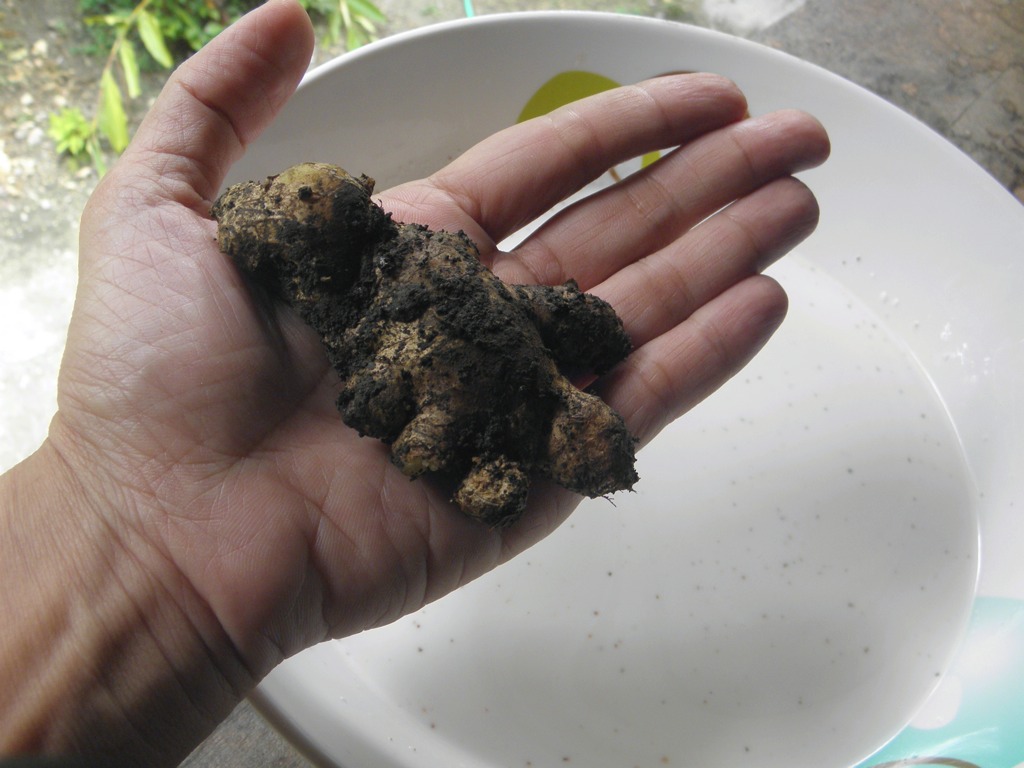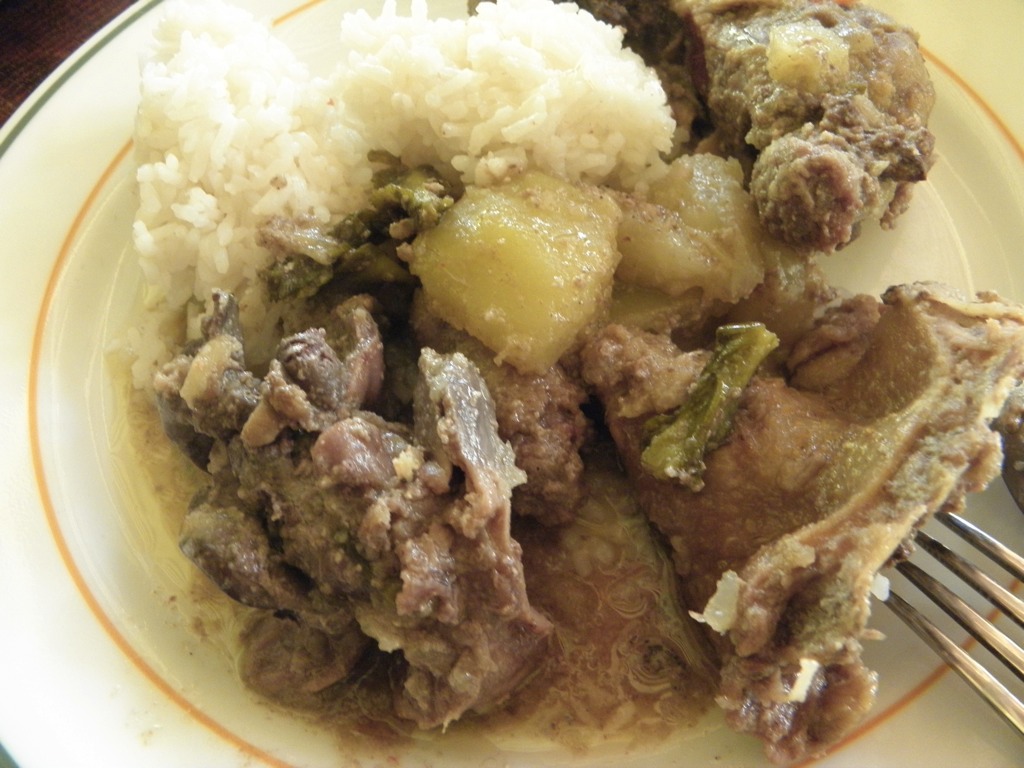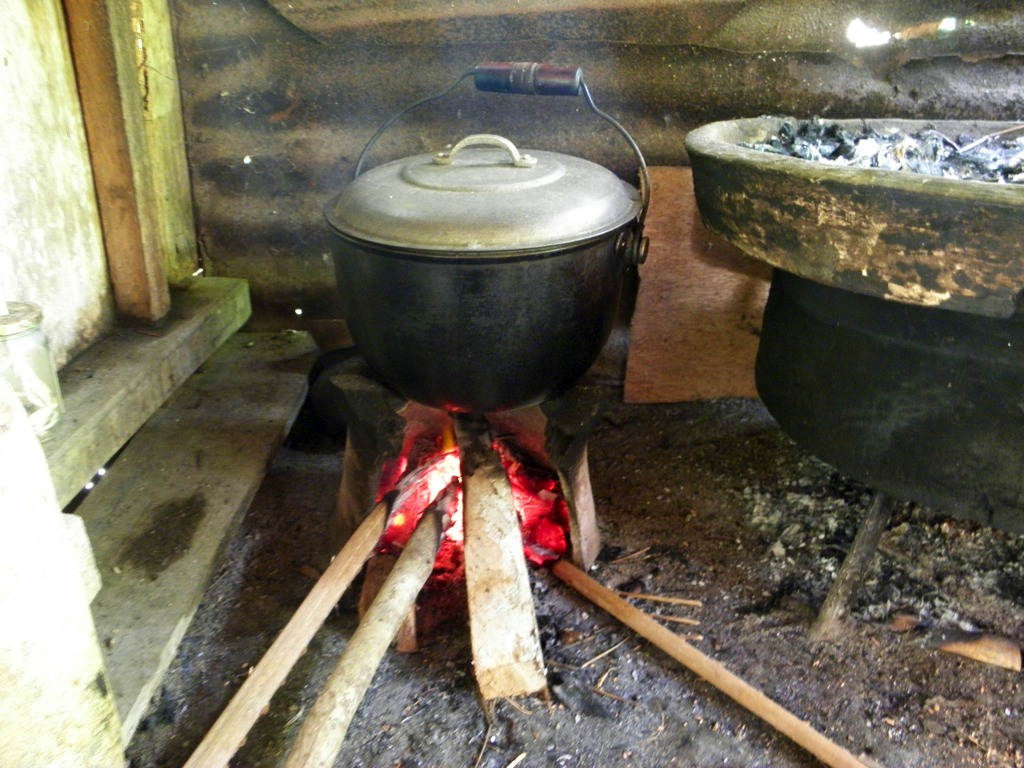
“Halang” means “spicy”, “chili hot” and for many in the Visayas and some in Mindanao, “halang-halang” is real comfort food. The meat used in halang-halang is chicken, preferably native chicken or manok Bisaya. In the Tagalog region, the “Halang-Halang” is often compared to the “Chicken Tinola.”
Regional Variations of the (Chicken) Halang-Halang
While there are regional variations, such as a dry stew or a clear broth, the base for “Chicken Halang-Halang” is often coconut milk. Green birds eye chilli provide the most exquisite heat although red chilli as well as siling haba or siling espada (long green chilli) can also be used. The subtle flavour of this delicacy also varies: ginger and lemongrass (tanlad) is the most widely used in Bohol. In some places it is turmeric (luyang dilaw). Others include basil leaves, peppercorns, Chinese chives or spring onions. In some instances, some vinegar is used to wash the meat if not added in the initial sautéing of the meat with the panakot (sauté ingredients such as garlic and onion) – a technique that helps reduce the gamey smell and taste of native chicken.

Vegetables to Use
The type of vegetables added to the stew vary, depending on tradition and availability. Fleshy vegetables are desired as focal ingredient since the native chicken does not have a lot of meat. Vegetables of choice may be sayote or unripe papaya. More expensive commercial vegetables such as potatoes and carrots may also be used instead.
Secondary vegetables add colour, contrast and subtle flavour to the stew. Examples used may one of or a combination of chilli leaves, string beans, spinach, malunggay leaves, and atsal (native red bell pepper). More interesting versions include the addition of (one or more of the following): coconut meat cut into strips, sliced bamboo shoots (labong), fish sauce (often added in the sauté), soy sauce (used to marinate the chicken for a few minutes),
“Halang-Halang” has strong spicy flavour so it needs to be eaten with a starchy staple such as rice. In Bohol, the famous ubi – boiled and peeled – particularly the white (kabus-ok) variety, is excellent.
Cooking “Halang-Halang” takes an hour or so, depending on the meat used. Older native chickens are tougher and can take longer to cook. So the best way to cook “Halang-Halang” is over wood fire, instead of gas or electricity, to be more economical. Wood fire also imparts this subtle smokey flavour to the stew, something which we often take for granted and then become nostalgic for when we move to the city and only use gas stoves or electric stoves.
A number of times we have used duck to make “Halang-Halang.” I have to admit that nothing beats the native chicken when it comes to “Halang-Halang”. Maybe this means we’ll need to improvise and invent a new variant of “Halang-Halang” that would be most suitable for duck.

Nevertheless, today’s experiment was a success, though not a resounding one. We used ingredients from the garden: unripe papaya, lemongrass, sigarilyas (winged beans), ginger, atsal, red and green chilli and coconut milk squeezed from fresh grated coconuts. We have not been successful growing garlic or onions so we had to get those from the public market.

Duck Bacon?
The duck carcass, about 4 months old, weighed 1.25kg. I took the breast and meaty thighs for an experiment in curing (or what I call, “duck bacon.”) The deboned breast weighed about 250 grams and the meat of the thighs (with small bone included) weighed about 150 grams. I’ll post about the duck bacon later.
Making a Better Pato Halang-Halang”
When we make “Pato Halang-Halang” again, I would do the following to improve the taste and texture of the dish: (1) use coconut oil instead of vegetable oil to improve the flavour; (2) use more lemongrass (duck and lemongrass go very well together!) and birds eye green chilli (instead of red chilli) and chilli leaves (add the chilli leaves last just to wilt it instead of over-cooking it, otherwise it will be bitter); (3) use the second extract of coconut milk to the sauté to bring out its flavour and use the first extract of coconut milk when the stew is 10-15 minutes from done (this will prevent the stew from becoming too oily because the first extract of coconut milk produces a lot of oil when cooked for long time; (4) add more onions to the sauté and allow it to caramelise with the duck for subtle sweetness; (5) use vinegar to marinate the duck meat for a smoother cleaner flavour; and (6) cut the winged beans into thinner slices and add all vegetables (like the unripe papaya) last so they don’t overcook; it is easy to overcook food when you’re cooking over a wood fire.
If you have experience with cooking “Halang-Halang” in your home province, please share with us what makes your “Halang-Halang” special!

Pato Halang-Halang
(We encourage you to improvise on this basic recipe – substitute with ingredients available in your location; learn about tastes (spicy? salty? sweet? creamy? sour?), textures (thick? dry? soupy? oily?) and flavour (fragrant? gamey? savoury? herbal?) that you prefer and modify the recipe to suit that. For example, you can sauté with a bit of fish sauce or patis to deepen the savoury taste or marinate the duck in soy sauce instead of vinegar to make a richer bolder flavour; add more or less chilli to your taste; substitute ginger with turmeric, etc.)
Ingredients:
800 grams to 1 kilo whole dressed Muscovy duck (pato)
1 cup white vinegar
1 green unripe papaya of medium size, cut into small chunks
3 small native red bell pepper, sliced into strips
5 winged beans cut into thin slices
Coconut milk from one coconut (separate first and second extract)
1 cup of water
2 medium sized onions (sliced) and one head of garlic (crushed)
2 stalk lemongrass, white pulpy stems crushed and tied into a bundle
Ginger about a thumb size, sliced and crushed
Whole green birds eye chilli (labuyo)
A handful of chilli leaves
Spring onion, chopped
1 teaspoon brown sugar
Salt and crushed peppercorns
Coconut oil
Directions:
Clean the duck and cut into serving sizes. Massage it with vinegar and let sit for a while. Prepare the other ingredients. Drain the duck when ready to cook.
Heat oil in a suitable size stock pot. Add onion and garlic. Sauté until fragrant. Add the duck, ginger and lemongrass. Sauté until the duck skin becomes light brown on all sides and some of the duck fat begins to ooze. Add sugar and stir to cook evenly.
Pour second extract of coconut milk to deglaze the stock pot. Continue cooking and mixing for about 2 minutes. Add water, then cover and simmer until the duck meat is tender. Add more water if you prefer a soupy stew.
Add green chilli, papaya and native red bell pepper. Add the first extract of coconut milk. Simmer until the papaya is soft. Add salt and peppercorns to taste. Remove from heat and add the chilli leaves and spring onions. Serve piping hot!






